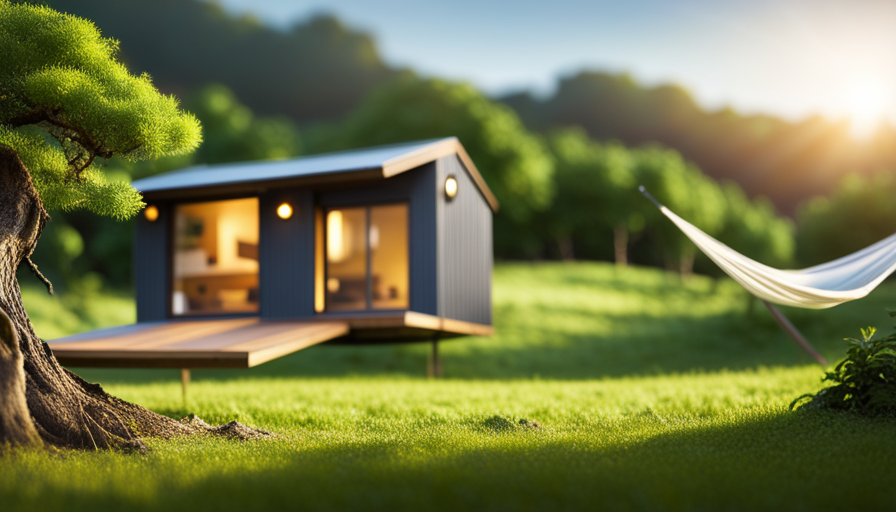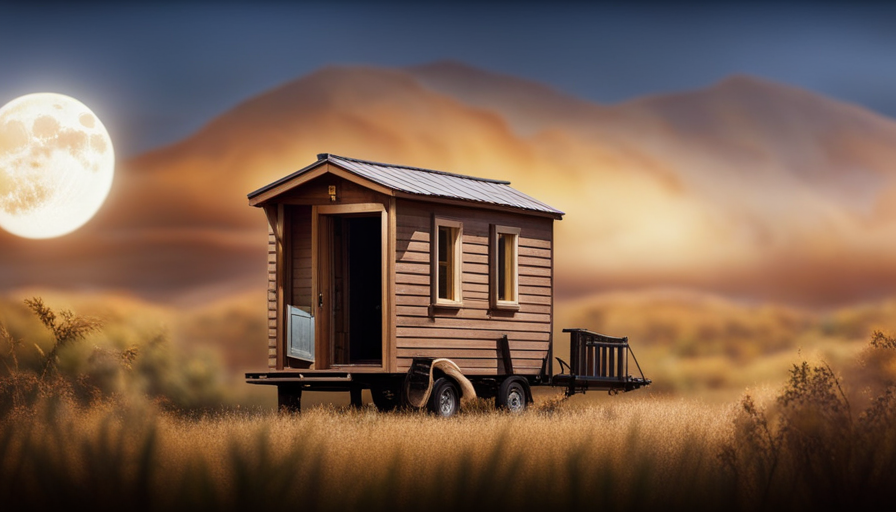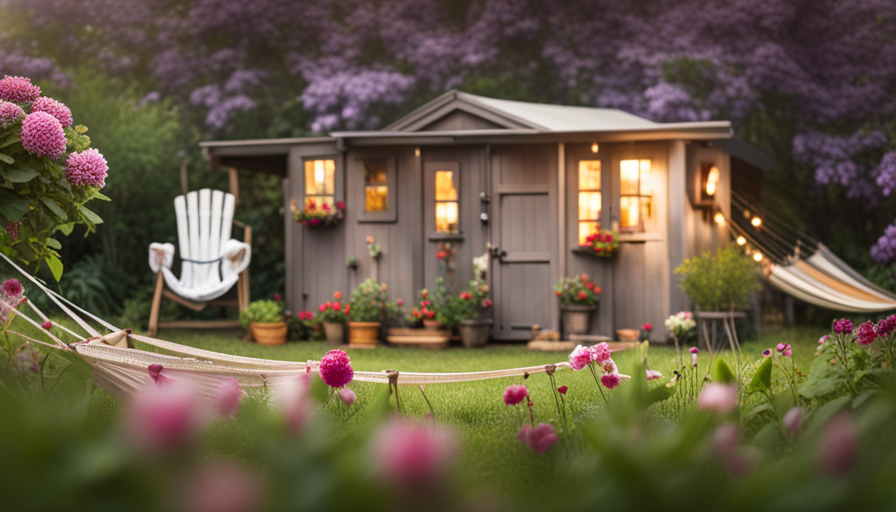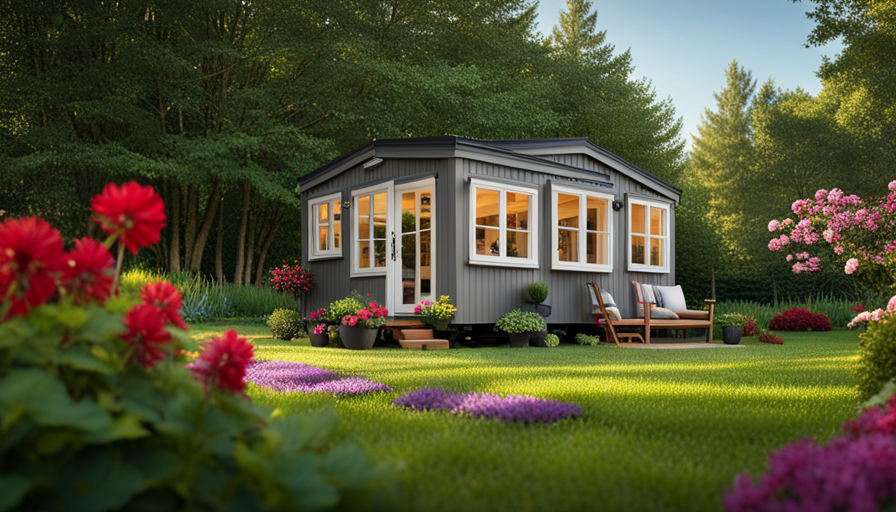Have you ever thought about how long a tiny house lasts? It may seem delicate and fleeting like a delicate flower, but is that really the truth?
Join me on a journey as we delve into the lifespan of these remarkable abodes, exploring the factors that influence their longevity and the secrets to making them stand the test of time.
Like a sturdy oak tree, the average lifespan of a tiny house depends on various factors. From the quality of materials used to the level of maintenance provided, every decision plays a role in determining how long these tiny havens can truly endure. Building codes and regulations also come into play, shaping the lifespan of these compact dwellings.
But fear not, for there are ways to extend the lifespan of these diminutive homes. Through innovative upgrades and renovations, we can breathe new life into them, enhancing their durability and functionality. And let’s not forget the inspiring case studies of long-lasting tiny houses, which will leave you in awe of their resilience.
So, whether you’re a tiny house enthusiast or simply curious about the hidden secrets behind their longevity, join me on this enlightening journey. Together, we’ll uncover the mysteries and unlock the potential of these captivating dwellings.
Key Takeaways
- Factors influencing the lifespan of tiny houses include the quality of materials, maintenance, building codes and regulations, location, and climate.
- Regular upkeep and maintenance are important to prevent structural issues, extend the lifespan, and allow for early detection of issues.
- Location and climate play a significant role, as extreme weather conditions can pose a risk and accelerate wear and tear.
- High-quality construction materials and techniques are crucial for the longevity of tiny houses.
Factors Affecting the Lifespan of Tiny Houses
So, how long do these little homes actually stick around? The longevity of tiny houses is influenced by several factors.
One of the most crucial factors is the quality of construction materials and techniques used. Since tiny houses are built on a smaller scale, it’s essential to ensure that sturdy and durable materials are utilized to withstand the test of time.
Additionally, the maintenance of these homes plays a vital role in their lifespan. Regular upkeep, such as inspecting for water damage, fixing leaks, and treating wood, can prevent structural issues and extend their longevity.
Another factor to consider is the location where the tiny house is situated. Extreme weather conditions, such as heavy rain or extreme heat, can impact the lifespan of the home. It’s essential to consider the climate and choose materials and construction methods that can withstand these conditions.
Furthermore, the lifestyle of the owner can also affect the tiny house’s lifespan. If the owner frequently moves the house or travels extensively, it may experience more wear and tear. On the other hand, a stationary tiny house that’s well-maintained and not subjected to constant movement may have a longer lifespan.
The longevity of tiny houses depends on various factors such as the quality of construction, maintenance, location, and lifestyle of the owner. Understanding these longevity factors and recognizing the importance of regular maintenance can help ensure that tiny houses last for many years to come.
Moving forward, let’s explore the average lifespan of these fascinating homes.
Average Lifespan of Tiny Houses
On average, tiny houses have a lifespan that may surprise you. Factors affecting longevity include the quality of construction materials, the level of maintenance, and the location where the tiny house is situated.
By using high-quality materials, such as durable siding and roofing, owners can significantly increase the lifespan of their tiny houses. Regular maintenance, such as checking for leaks, inspecting the foundation, and addressing any structural issues promptly, is also crucial in ensuring the longevity of a tiny house. Additionally, the location where the tiny house is placed plays a significant role in its lifespan. Extreme weather conditions, such as heavy snowfall or high winds, can put stress on the structure and potentially shorten its lifespan. To increase the lifespan of a tiny house, owners should consider reinforcing the structure to withstand these conditions.
Proper maintenance is essential for ensuring the longevity of a tiny house. In the next section, we will discuss the importance of proper maintenance and provide tips for keeping your tiny house in top shape.
Importance of Proper Maintenance
Take a moment to appreciate the irony of neglecting maintenance on your adorable, compact abode and the consequences it can have on its overall lifespan. Proper maintenance is crucial for the longevity of tiny house components. Regular upkeep ensures that your tiny house remains in good condition and can continue to provide a comfortable living space for years to come.
To emphasize the importance of regular maintenance, let’s take a look at a comparison table showcasing the potential consequences of neglecting upkeep:
| Neglected Maintenance | Proper Maintenance |
|---|---|
| Structural damage | Early detection of issues |
| Leaks and water damage | Preventive measures |
| Deterioration of materials | Extended lifespan |
As you can see, neglecting maintenance can lead to significant problems such as structural damage, leaks, and deterioration of materials. On the other hand, proper maintenance allows for early detection of issues and the implementation of preventive measures, ultimately extending the lifespan of your tiny house.
Transitioning into the subsequent section about building codes and regulations, it is important to note that regular maintenance not only ensures the longevity of your tiny house but also helps you comply with building codes and regulations. These guidelines exist to ensure the safety and well-being of occupants, and neglecting maintenance can result in violations and potential legal issues.
Building Codes and Regulations
When it comes to building a tiny house, understanding and complying with building codes and regulations is crucial.nnNot only does it ensure legal requirements are met, but it also impacts the longevity and durability of the structure.nnBy following these guidelines, I can ensure that my tiny house is built to code, minimizing any potential issues and maximizing its lifespan.
Compliance and Legal Requirements
Did you know that complying with legal requirements is crucial when it comes to living in a tiny house and ensuring its long-term sustainability? The compliance challenges and legal restrictions surrounding tiny houses can be complex and varied.
Each region and municipality may have different regulations regarding the size, location, and even the materials used in constructing a tiny house. It is important to thoroughly research and understand these requirements to avoid any legal issues or fines. Additionally, complying with these regulations can also impact the longevity and durability of a tiny house.
By adhering to building codes and legal requirements, you can ensure that your tiny house is built to withstand the test of time and any potential environmental factors.
Transitioning into the next section, it is essential to consider the impact on longevity and durability when building a tiny house.
Impact on Longevity and Durability
When it comes to living in a tiny house, compliance with legal requirements is crucial. However, it’s also important to consider the impact of the environment on the longevity and durability of these homes. The climate plays a significant role in determining how long a tiny house can last. Harsh weather conditions such as extreme heat, cold, or heavy rain can accelerate wear and tear, leading to shorter lifespans.
Additionally, the maintenance costs and efforts required to keep a tiny house in good condition shouldn’t be underestimated. Regular inspections, repairs, and upkeep are necessary to ensure the longevity of the structure. As the climate and maintenance play a vital role in the lifespan of a tiny house, it’s essential to consider these factors before making the decision to downsize.
In the next section, we’ll explore the various upgrades and renovations that can be done to enhance a tiny house.
Upgrades and Renovations
If you’re looking to give your tiny house a fresh new look, there’s no shortage of upgrades and renovations to make your compact living space even more stylish and functional. Upgrading appliances is a popular choice among tiny house owners, as it can improve efficiency and add modern convenience to the limited space. From energy-efficient refrigerators to compact washer-dryer combos, there are plenty of options available that fit perfectly into the tiny house lifestyle.
Another aspect of upgrading your tiny house is staying up-to-date with interior design trends. While the size of the space may be small, that doesn’t mean you have to sacrifice style. Incorporating elements like minimalist furniture, clever storage solutions, and strategically placed mirrors can create the illusion of a larger space. Additionally, choosing a color scheme that maximizes natural light and using multi-purpose furniture can make your tiny house feel more open and versatile.
To help you visualize the possibilities for upgrading your tiny house, here is a table showcasing some popular upgrades and renovations:
| Upgrade/Renovation | Description | Benefits |
|---|---|---|
| Solar Panels | Harnessing renewable energy | Lower energy costs, reduced carbon footprint |
| Loft Extension | Adding additional sleeping or storage space | Increased functionality, more room for personal belongings |
| Outdoor Deck | Expanding living space | Outdoor entertainment area, connection with nature |
| Smart Home Technology | Automating and controlling various aspects of the house | Convenience, energy efficiency |
By investing in these upgrades and renovations, you can enhance the functionality and aesthetics of your tiny house. However, it’s important to consider the longevity of different types of tiny houses, as this will ultimately determine how long you can enjoy your upgraded living space.
Longevity of Different Types of Tiny Houses
To truly make your compact living space last, it’s important to consider the durability and lifespan of various types of tiny houses. Factors such as construction materials, design, and maintenance can greatly affect how long a tiny house will last.
For instance, a tiny house built with high-quality, durable materials like steel or concrete will likely have a longer lifespan compared to one made with less sturdy materials like wood or vinyl. Additionally, the design of the house, including its foundation and structural integrity, can impact its longevity. Regular maintenance, such as checking for leaks or repairing any damage, is also crucial in prolonging the life of a tiny house.
Furthermore, the environmental impact of a tiny house can also affect its longevity. Choosing sustainable materials and incorporating energy-efficient features can not only reduce the environmental footprint of the house but also contribute to its longevity. For example, using renewable energy sources like solar power can help minimize the dependence on traditional energy sources and reduce the wear and tear on the house’s electrical systems.
Considering these factors and making informed choices during the construction and maintenance of a tiny house can significantly increase its lifespan. This longevity can bring many benefits, such as reduced maintenance costs and a smaller environmental impact.
Transitioning to the next section, let’s explore the pros and cons of longevity in tiny houses.
Pros and Cons of Longevity in Tiny Houses
Transition: Now that we’ve discussed the longevity of different types of tiny houses, let’s delve into the pros and cons of living in these small spaces for an extended period of time.
Living in a tiny house certainly has its advantages. One of the main benefits is the ability to downsize and simplify your life. With limited space, you’re forced to declutter and prioritize only the essentials, leading to a more minimalist lifestyle. This can bring a sense of freedom and a reduction in stress.
Additionally, the financial implications of living in a tiny house are often positive. With lower utility costs, reduced maintenance, and potentially no mortgage, tiny house living can provide significant savings.
However, there are also drawbacks to consider. One major concern is the lack of space, which can make it challenging to entertain guests or accommodate a growing family. Additionally, storage can be limited, requiring creative solutions to maximize usable space. Another potential drawback is the depreciation of the tiny house’s value over time, which may affect resale options in the future.
As we move forward, it’s essential to explore case studies of long-lasting tiny houses to gain a deeper understanding of their durability and sustainability, and how they’ve overcome these challenges.
Case Studies of Long-Lasting Tiny Houses
Let’s explore real-life examples of tiny homes that have stood the test of time, showcasing their longevity and sustainability. Case studies provide valuable insights into how these small dwellings can endure and remain functional for extended periods.
One noteworthy example is the Tumbleweed Tiny House Company’s Cypress model, which has been around for over a decade. This tiny house has proven to be durable and well-built, with many owners reporting that it still looks and feels as good as new.
Another case study is the Minim House, designed by Brian Levy. This tiny house has been around for over seven years and has weathered various climates, from the scorching heat of Arizona to the freezing winters of Vermont. The Minim House’s longevity can be attributed to its high-quality construction and attention to detail.
These real-life examples demonstrate that with proper planning, design, and construction, tiny houses can last for a significant amount of time. By focusing on durability and using sustainable materials, we can extend the lifespan of tiny houses, allowing them to be enjoyed for generations to come.
Extending the Lifespan of Tiny Houses
When it comes to extending the lifespan of tiny houses, two key points to consider are sustainable and eco-friendly practices, as well as choosing durable and resilient materials.
By implementing sustainable practices such as using renewable energy sources and minimizing waste, tiny house owners can reduce their environmental impact and ensure their homes remain in good condition for longer.
Additionally, selecting materials that are known for their durability and ability to withstand various weather conditions can help to extend the lifespan of a tiny house, reducing the need for frequent repairs or replacements.
Sustainable and Eco-Friendly Practices
Are tiny houses truly sustainable and eco-friendly, or are they just another passing trend? When it comes to sustainability, tiny houses have a lot to offer. Many builders are using sustainable building materials, such as reclaimed wood, recycled metal, and low VOC paints, to minimize their environmental impact.
Additionally, energy efficient design is a common feature in tiny houses, with options like solar panels, efficient insulation, and LED lighting. These practices not only reduce the carbon footprint but also help homeowners save on energy costs.
Moreover, tiny houses promote a minimalist lifestyle, encouraging people to consume less and live more sustainably. While the trend of living in tiny houses may come and go, the sustainable and eco-friendly practices associated with them are here to stay.
In the next section, we will explore the importance of choosing durable and resilient materials.
Choosing Durable and Resilient Materials
To ensure the longevity and resilience of your sustainable home, it’s crucial that you carefully select durable and resilient materials for construction. When it comes to building a tiny house, it’s important to choose materials that can withstand the test of time and the elements.
Opting for durable materials such as steel or concrete for the foundation and framing can provide a solid and sturdy structure. Additionally, using resilient construction techniques like reinforced insulation and weather-resistant siding can help protect your tiny house from wear and tear.
It’s also wise to consider materials that require minimal maintenance, as this can save you time and money in the long run. By selecting durable and resilient materials, you can ensure that your tiny house will stand strong for years to come.
Transitioning into the subsequent section about ‘conclusion: making the most of your tiny house journey’, it’s important to remember that the materials you choose are just one aspect of creating a sustainable and fulfilling living experience.
Conclusion: Making the Most of Your Tiny House Journey
Remember, you can truly maximize your tiny house journey by making the most of every moment and embracing the opportunities it brings. Living in a tiny house may seem challenging at first, but with the right mindset and a few key strategies, you can create a fulfilling and memorable experience.
-
Making memories: One of the greatest advantages of living in a tiny house is the opportunity to create lasting memories. With limited space, you’re forced to be intentional with your choices and prioritize what truly matters to you. Whether it’s hosting intimate gatherings with close friends or enjoying cozy movie nights with your loved ones, every moment becomes a cherished memory.
-
Maximizing space: Another aspect of the tiny house lifestyle is the constant quest for maximizing space. From utilizing multi-functional furniture to clever storage solutions, there are endless possibilities to make the most of every square inch. By adopting a minimalist mindset and keeping only the essentials, you can create a clutter-free environment that promotes relaxation and creativity.
-
Embracing simplicity: Living in a tiny house encourages a simpler way of life. It allows you to let go of unnecessary possessions and focus on what truly brings you joy. By embracing simplicity, you can reduce stress, increase mindfulness, and create a more meaningful and fulfilling life.
Your tiny house journey is what you make of it. By making memories, maximizing space, and embracing simplicity, you can truly make the most of this unique and rewarding experience. So, embrace the challenges, savor the moments, and create a life filled with joy and contentment in your tiny house.
Frequently Asked Questions
Is it possible to build a tiny house that lasts for decades?
Yes, it’s possible to build a tiny house that lasts for decades. Design considerations for long-lasting tiny houses include using durable materials, proper insulation, and a solid foundation.
Environmental factors affecting the lifespan of tiny houses include exposure to harsh weather conditions, moisture, and pests. By addressing these factors and incorporating smart design choices, a well-built tiny house can stand the test of time and provide a comfortable living space for many years to come.
What are some common mistakes that can lead to a shorter lifespan for a tiny house?
Common mistakes in designing tiny houses can significantly reduce their lifespan. One such mistake is poor insulation, leading to moisture buildup and mold growth.
Another common error is using subpar materials that deteriorate quickly.
To increase the lifespan of a tiny house, regular maintenance practices are essential. This includes inspecting and repairing any leaks or cracks, properly ventilating the space, and regularly cleaning and treating the exterior.
These measures will ensure a longer and more enjoyable life for your tiny home.
Are there any specific building materials that are known to increase the longevity of a tiny house?
Building materials play a crucial role in increasing the longevity of a tiny house. When considering longevity factors in tiny house construction, it’s important to choose durable and weather-resistant materials.
Some recommended building materials for long-lasting tiny houses include steel or metal frames, high-quality insulation, and rot-resistant woods like cedar or redwood. These materials provide structural strength, protection against the elements, and resistance to decay, ensuring that the tiny house remains sturdy and durable for many years to come.
How often should I inspect and maintain my tiny house to ensure it lasts as long as possible?
Inspecting and maintaining your tiny house is crucial to ensure its longevity. Regular inspections, like peering into the abyss of a dark, cramped attic, should be done at least once a year. Look out for any signs of water damage, like leaky faucets or ominous puddles.
To prevent water damage, you can employ measures such as installing a sturdy roof, using weather-resistant materials, and sealing any gaps. Remember, a well-maintained tiny house can stand the test of time, just like that leftover pizza in your fridge.
Can I make significant upgrades or renovations to my tiny house without compromising its lifespan?
Yes, it’s possible to make significant upgrades or renovations to a tiny house without compromising its lifespan. However, it’s crucial to ensure the structural integrity of the house remains intact during the process. When upgrading appliances, it’s important to consider their size, power requirements, and compatibility with the existing electrical system. Additionally, any modifications made should be done carefully to maintain the overall stability and safety of the tiny house.
Conclusion
In conclusion, it’s evident that proper maintenance and adherence to building codes and regulations play a crucial role in determining the lifespan of tiny houses.
However, one interesting statistic to note is that on average, tiny houses have a lifespan of around 25 years. This highlights the importance of investing in upgrades and renovations to extend their longevity.
By taking care of our tiny houses and making necessary improvements, we can ensure that our journey in these unique homes remains enjoyable and sustainable for many years to come.
Hi, I’m Emma. I’m the Editor in Chief of Tiny House 43, a blog all about tiny houses. While tree houses are often associated with childhood, they can be the perfect adult retreat. They offer a cozy space to relax and unwind, surrounded by nature. And since they’re typically built on stilts or raised platforms, they offer stunning views that traditional homes simply can’t match. If you’re looking for a unique and romantic getaway, a tree house tiny house might just be the perfect option.










